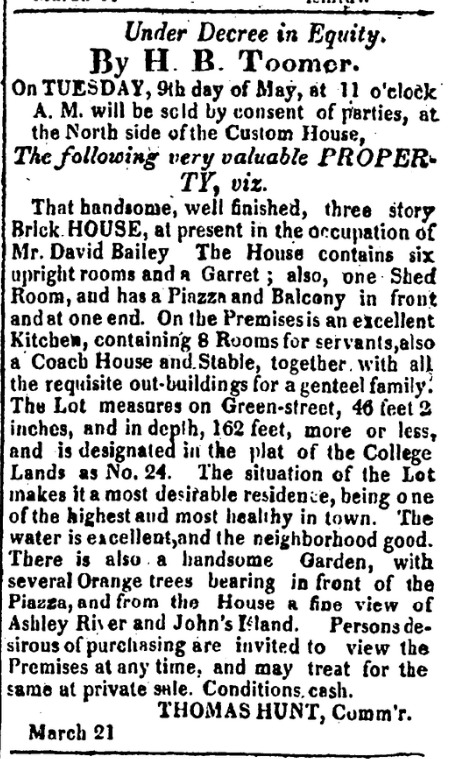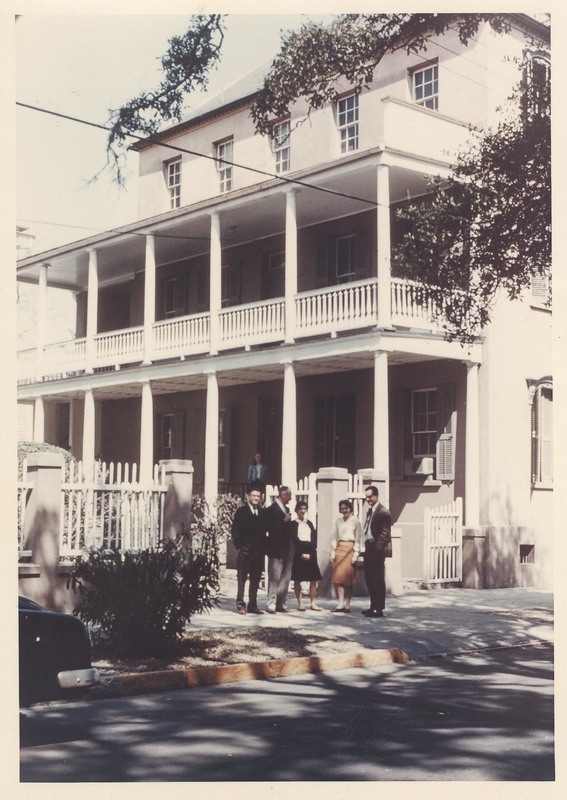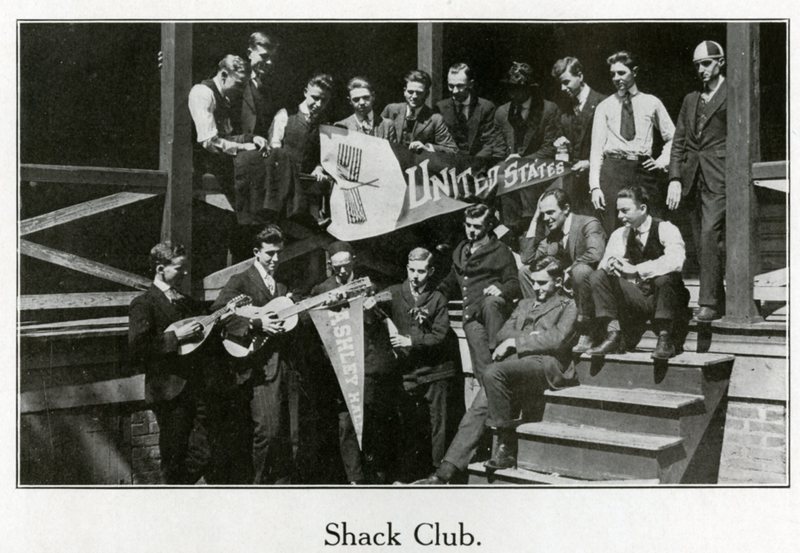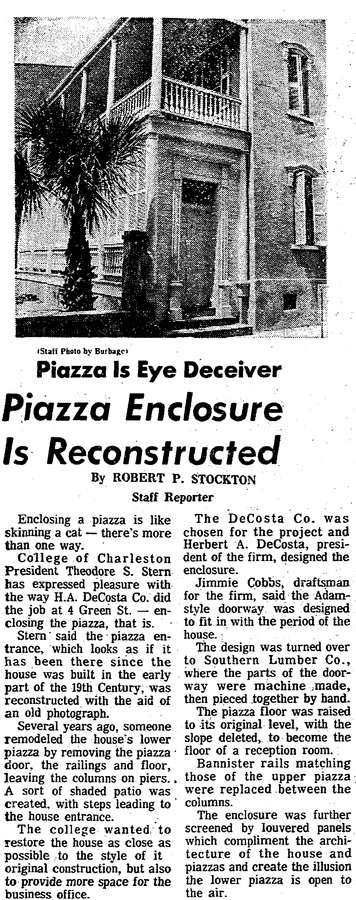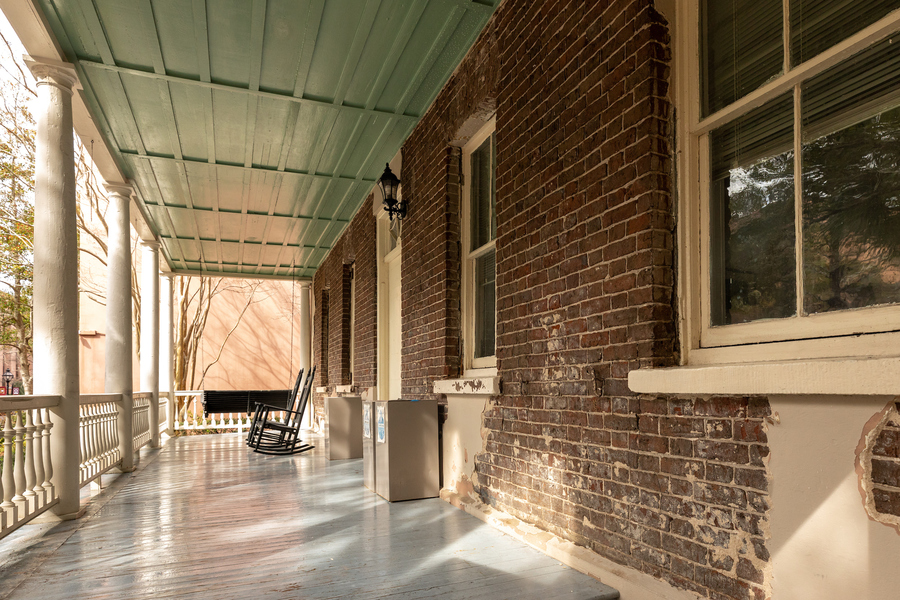
Since purchasing the house in 1901, the College has used it as a residence hall, faculty apartments, barracks, fencing court, lab and offices. Ill-treated by student residents in the early 20th century, the house was known as “The Shack.”
This house’s first owner was David D. Bailey, who purchased Lot 24 from the College in 1817 and, not long afterward, had this fine Charleston single house built for his young family. A decade later, after Bailey’s death, the house was offered for sale as a “handsome, well finished, three story Brick House.” The College of Charleston was a struggling institution in the 1820s, but the ad for the sale of the Bailey house extolled its location just north of the site where Randolph Hall would soon be built: “a most desirable residence, being one of the highest and most healthy in town. The water is excellent, and the neighborhood good. There is also a handsome garden, with several orange trees bearing in front of the piazza, and from the house a fine view of Ashley River and Johns Island.”
In 1901, the College purchased the house from Hannah Trieste and opened 4 Green St. as a dormitory where out-of-town students could live and take their meals. One resident who later became a CofC professor, Robert Coleman, recalled nailing a shoe to the fireplace in his room so that he “could lean back in my chair and put my foot in the shoe which the fire kept warm at all times.” Students dubbed the house “The Shack” and formed a “Shack Club.” In 1917, during World War I, the club’s yearbook photo lists the motto “Drink, smoke and be merry, for tomorrow you may get shot.” That same year, when the dining costs exceeded the rates students were paying, the College discontinued serving meals, but in 1918, meal service resumed, this time subsidized by the U.S. military’s Student Army Training Corps program. The College received $1.30 per day to feed and house each student who slept at 4 Green St. and in other makeshift barracks on campus. The military program ended in late 1918, but students continued to live at 4 Green St.
“The Shack” remained a site of rowdy behavior. Board of Trustees minutes from 1921 report, “It seems clear that the system of student-government which gave entire latitude of action to the student-boarders is not suited to the reckless, irresponsible spirit of the present-day undergraduate.” Because of “wanton destruction of Dormitory property and a serious infringement of the rights of the Dormitory neighbors,” the College closed the dormitory and barred these students from living there when it reopened the following year. (Members of “The Ex-Shack Club” in a 1921 yearbook photo are probably these badly behaved students. Their stated motto: “We will do anything but what is right; if we ever did a good deed, we are sorry.”)
By 1929, 4 Green St. held faculty offices and science lab rooms. The 1936 Board of Trustees minutes report repairs and renovations to the building courtesy of New Deal employment programs; there was now space for the Dramatic Society, the college magazine and yearbook, a fencing court, and an apartment for a faculty member who presumably prevented the “wanton destruction” of earlier years. For the next three decades the building was mainly used for offices and classrooms, then as housing for faculty who might not otherwise be willing to come to the College, where salaries were considered low. In 1960, the building was converted into the first women’s residence hall.
New dormitory space for women opened in 1967, and this house was again used for offices. In 1974, President Ted Stern engaged the firm of well-known African American contractor and Charleston architect H. A. DeCosta to restore 4 Green Way to its original appearance.
Green and College Streets were converted into pedestrian walkways in 1971, paved in herringbone-patterned brick. Brick or stucco was also used in new structures – residence halls, a new library, a classroom building – surrounding the remaining old buildings. For its historic buildings, the campus was designated a National Historic Landmark.
Currently, 4 Green Way houses offices for mathematics faculty.
Audio
Images


